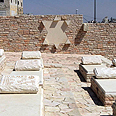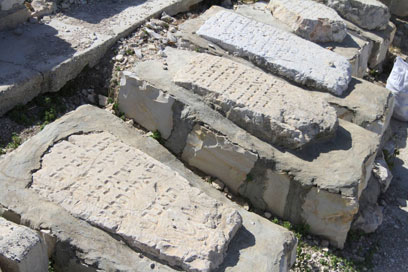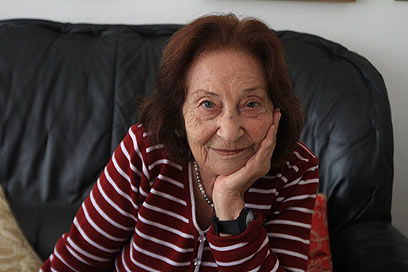
Hershler was killed in January 1873, at the age of 23, as a result of gunfire of an Arab cell that penetrated his neighborhood – Mishkenot Shananim – the first Jewish neighborhood outside Jerusalem's Old City's walls. He is buried at the Mount of Olives and his life story is commemorated on the Defense Ministry's website.
Related stories:
- Lehi fighter Tova Svorai dies at 97
- From the memoirs of the fighting Pearl family
- ‘Good year’ greetings from good years past
He was born in Hungary to a prominent rabbi who later headed a yeshiva when the family immigrated to Israel.
Hershler is considered a casualty of the pre-State undergrounds.
The story and the legend
On Gimel of Tevet 1874, Arabs broke into the Hershler family house, most likely in search of money or valuables. Because of the massive rain that year, the neighborhoods reservoirs were full, and the Jews had stopped purchasing their water from the Arabs, which seemed to exact an economic price from the locals.
Hershler returned home from his studies and noticed the thieves. He scared the gang away and began chasing them. Fearing their identity would become known, they shot him 12 times. Hershler sustained serious injuries, and four days later succumbed to his wounds and passed away at the hospital. He was survived by a wife, a daughter, parents and brothers.

Hershler's grave (Photo: Gil Yohanan)
The yeshiva in which he pursued his studies is still active today, and is called Kolel Shomrei Hatorah (The Keepers of the Torah Yeshiva), considered one of the most devout in the haredi community.
'Justice has been done'
Hershler's great-granddaughter, Bila Shamir, 85, recalls the legends she heard about her great-grandfather during her childhood. "I grew up with my grandmother in Safed. Her mother was six-months pregnant with her when Hershler was killed, and she wasn’t alive when he was recognized as part of Israel's fallen," she told Ynet.

Bila Shamir (Photo: Gil Yohanan)
"From what I heard," Shamir added, "they lived in Mishkenot Shananim and the windmill, which wasn’t working properly at the time because its wings were built facing north instead of south, was being used as a warehouse for flour, and Hershler was in charge of keeping watch over them.
"One night he heard a noise and went to examine what it was, then he came face to face with the Arabs and they killed him."
Bila served in the Palmah and her brother and son, both named after Hershler, both served in the army as high ranking officers. When asked about Hershler's haredi lifestyle she said: "They were haredim, but they also worked. Hadas, Hershler's wife, sold flour and was the city's first female merchant.
"This is a family of gifted prodigals; some of my cousins are rabbis. Every one in Mea Sha'arim (a haredi neighborhood in Jerusalem) knows the story of Hershler's death and they are proud of him 'till today."
After describing the heavy rains falling on the city, the first Hebrew paper – The Lebanon – published on February 5, 1873 described multiple complaints lodged with the Ottoman authorities regarding thefts perpetrated by local Arab farmers. It then reported the event of Hershler's death:
"A few days ago, thieves broke into the house of a Jewish man living outside the city walls in Mishkenot Shananim. He then fled his house in pursuit of these thieves, chasing them with his son-in-law, and the thieves fired at them with a rifle, and twelve bullets brought death unto the son-in-law and after four days he died in pain from his wounds at the Rothschild's Hospital. Until today, the identity of the murders is unknown. However, on their way to Jordan, around Jericho, the thieves formed an ambush, killing a farmer and his black servant."
Hershler is one of the few fallen to have died during the 19th century, and almost all of the fallen from this period are haredi Jews trying to protect other Jews during Arab riots in the city.
First female casualty
The first female casualty of this period is one of the first settlers in Petah Tikva – Rahel Hadad Halevy –who was killed when Arab marauders broke into the settlement with the intent of wreaking havoc and beat her to death.At the time of the incident the settlement's men were all meeting with the Turkish governor in Jaffa to complain about just such incidents.
Halevy attempted to save the settlemtents' women and children by protecting them with her body and paid for her bravery with her life on April 1886.
It is important to note that Israel has not always incorporated those killed before the State's formation in its list of fallen. Only in 1980 was an amendment made to the General Memorial Day for the Fallen of Israel's Wars Law to include those who were part of the underground movements prior to the State's formation as well Shin Bet and Mossad agents.
At the end of an extensive research study conducted by the Defense Ministry for the sake of the amendment, the names of these fallen were collected and organized, dating back to 1860.
"There is no doubt that justice has been made when they recognized the underground's casualties as fallen," Bila Shamir, Hershler's great-granddaughter, concluded.
- Receive Ynetnews updates
directly to your desktop















